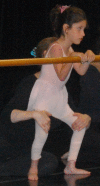Dance program for physical rehabilitation and participation in children with cerebral palsy
- PMID: 25431617
- PMCID: PMC4226305
- DOI: 10.1080/17533015.2011.564193
Dance program for physical rehabilitation and participation in children with cerebral palsy
Abstract
Objective: This pilot study aimed to examine a classical ballet program created for children with cerebral palsy (CP) as an emerging physical rehabilitation modality. The main program goals were to promote participation and to provide an artistic, physically therapeutic activity. Methods: The study was conducted in collaboration with a tertiary rehabilitation hospital, one outpatient physical therapy clinic, and one community center. As a pilot exploratory study, the research design included questionnaires to assess the participants' (children (n = 16), parents (n = 16), and therapists (n = 13)) perceptions on the therapeutic benefit of the dance program. A binomial statistical model was adopted for the analysis of the results. Results: Main results were that the children reported high enjoyment level (p < .0001) and desire for more classes (.0001); the parents reported perceived therapeutic benefit (p < .0001); and the therapists viewed the class as a positive adjunct to therapy (p < .0001). Conclusions: The main limitation of this work was the utilization of subjective outcome measures. However, this is the first step toward the development of objective measures of an intervention that, to our knowledge, has not been analyzed in the past. We conclude that the program has the potential of developing into an evidence based rehabilitation resource for children with CP.
Keywords: cerebral palsy; children; dance; participation; physical rehabilitation.
Figures
References
-
- Anttila H., Suoranta J., Malmivaara A., Makela M., Autti-Ramo I. Effectiveness of physiotherapy and conductive education interventions in children with cerebral palsy: A focused review. American Journal of Physical Medicine and Rehabilitation. 2008;87:478–501. - PubMed
-
- Bottcher L. Children with spastic cerebral palsy, their cognitive functioning, and social participation: A review. Child Neuropsychology. 2010;16:209–228. - PubMed
-
- Bottcher L., Flachs E.M., Uldall P. Attentional and executive impairments in children with spastic cerebral palsy. Developmental Medicine and Child Neurology. 2010;52:e42–e47. - PubMed
-
- Bower E., Michell D., Burnett M., Campbell M.J., McLellan D.L. Randomized controlled trial of physiotherapy in 56 children with cerebral palsy followed for 18 months. Developmental Medicine and Child Neurology. 2001;43:4–15. - PubMed
Grants and funding
LinkOut - more resources
Full Text Sources
Medical
Research Materials
Miscellaneous

